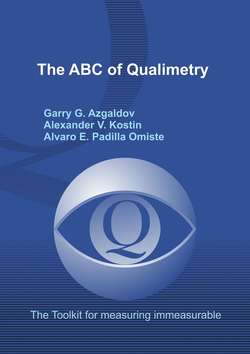Читать книгу The ABC of Qualimetry. The Toolkit for Measuring Immeasurable - Garry G. Azgaldov, Alexander V. Kostin - Страница 9
Chapter 1. Qualimetry in Outline
1.1.3.3. Qualimetry in Russia Today
ОглавлениеWhat we briefly considered above is the past history of qualimetry. What about its present?
Formally, if our analysis of the progress of qualimetry over a period of 43 years since its inception should rely on absolute numbers alone it may show a fairly optimistic picture. However, it would be more appropriate to evaluate qualimetry by the same qualimetric approach, i.e., to consider not only absolute but also relative figures versus some benchmark or performance potential. We will apply this approach and try to show both the progress in and failures associated with the development of qualimetry. (Naturally, this analysis will take into account qualimetry-related facts and figures from the Soviet era as well as from the period of independent development of the Russian Federation).
As regards the scientific aspect, it may be noted that in the 1980s an Applied Qualimetry Laboratory operated at the National Research Institute for Standardisation and an educational qualimetry laboratory at the Academy of Pedagogical Sciences. These facts are gratifying by themselves. The word qualimetry was after a while removed from its title, and the laboratory changed its subject altogether. Something similar happened to the educational qualimetry laboratory.
Regarding another source of new scientific data in qualimetry, dissertation-oriented research, five doctoral and more than 45 master’s theses on qualimetric subjects have been defended to date. Not bad for a fledgling discipline. Unfortunately, the vast majority of this research deals with applied rather than theoretical qualimetry; in other words, qualimetry research is mostly growing, so to speak, in breadth not in depth.
In the Soviet era, two national scientific conferences dealt with qualimetry topics, one held in Tallinn (1972), the other in Saratov (1988); also, standing inter-republican scientific workshops were conducted in Moscow and Leningrad in the late 1980s. Due to a tight economic situation in which Russian science found itself in the 1990sthese workshops ceased functioning. (nor is there any news call) Perhaps the only positive development in this regard is an annual workshop (held since 1991) open to CIS participants, which deals with educational and health care applications of qualimetry.
It should be noted that qualimetry issues are discussed at special sections (or panels) of international conferences held by the European Organisation for Quality Control and the Asian Institute of Quality Management (Moscow – 1971., Oslo – 1974, Varna -1977; Yerevan – 1982, Madrid – 1983, Moscow – 1988, Delhi – 1989).
In addition, reports on the application of qualimetry to scientific and practical problems in other areas have been presented at more than national-scale 90 conferences, symposia and seminars held in Voronezh, Zvenigorod, Yerevan, Kiev, Kishinev, Krasnodar, Lviv, Leningrad, Moscow, Novosibirsk, Odessa, Pushchino, Riga, Saratov, Suzdal, Tambov, Tartu, Tashkent, Tbilisi, Uzhgorod, Ivano-Frankovsk and Kharkiv.
Qualimetry as an independent scientific discipline is taught in dozens of technical universities in Russia (the name of the academic subject is “Quality Control”).
Yet, given the multisectorial and interdisciplinary nature of qualimetry, these kinds of academic convention should be much more frequent, for experience shows that out of every 10 researchers (from junior research fellowsto members of the Russian Academy of Sciences) hardly one has ever heard anything about qualimetry and its potential.
Administrative staff shows no greater familiarity with the essence and potential of qualimetry. Indicative in this respect is the practice of top government statistical agencies, both in the Soviet Union and afterwards in Russia. In their published annual, semi-annual and quarterly statistical reports almost every one of the 800—1200 figures contained therein refer to either quantitative or purely economic (cost) performance indexes of the national economy. As for quality, at best they list sometimes (not always) the numbers of new Quality Seals. Quantitative assessments of quality level (by industry or product group – not to mention the quality of life) were not cited even once!
It is a good thing that qualimetry topics are dealt with by hundreds of scientific papers, including more than 80 monographs and that special subject headings are found in catalogues of some of the largest libraries in Russia: the National Library of Russia, the GPNTB, the Institute of Scientific Information in the Social Sciences and others, and that articles on qualimetry are included in the Greater Soviet, Russian and Economic encyclopaedias.
